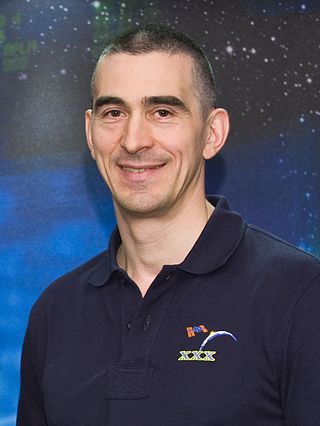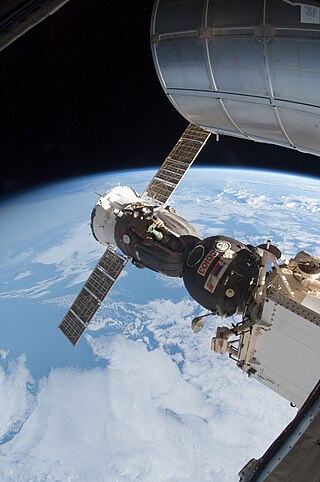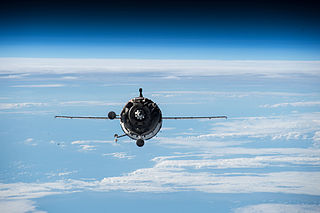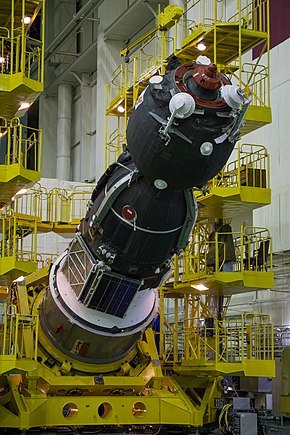
Soyuz is a series of spacecraft which has been in service since the 1960s, having made more than 140 flights. It was designed for the Soviet space program by the Korolev Design Bureau. The Soyuz succeeded the Voskhod spacecraft and was originally built as part of the Soviet crewed lunar programs. It is launched on a Soyuz rocket from the Baikonur Cosmodrome in Kazakhstan. Between the 2011 retirement of the Space Shuttle and the 2020 demo flight of SpaceX Crew Dragon, the Soyuz served as the only means to ferry crew to or from the International Space Station, for which it remains heavily used. Although China did launch crewed Shenzhou flights during this time, none of them docked with the ISS.

Sergey Nikolayevich Ryzhikov, lieutenant colonel of Russian Air Force, is a Russian cosmonaut, selected in 2006. He is a veteran of two long duration space flights to the ISS.

Soyuz TMA-19 was a crewed spaceflight to the International Space Station (ISS) and is part of the Soyuz programme. It was launched on 15 June 2010 carrying three members of the Expedition 24 crew to the International Space Station, who remained aboard the station for around six months. Soyuz TMA-19 was the 106th crewed flight of a Soyuz spacecraft, since the first mission which was launched in 1967. The spacecraft remained docked to the space station for the remainder of Expedition 24, and for Expedition 25, to serve as an emergency escape vehicle. It undocked from ISS and landed in Kazakhstan on 26 November 2010. It was the 100th mission to be conducted as part of the International Space Station programme since assembly began in 1998.

Andrey Ivanovich Borisenko is a Russian cosmonaut. He was selected as a cosmonaut in May 2003, and is a veteran of two long duration missions to the International Space Station.

Soyuz TMA-22 was a crewed spaceflight to the International Space Station (ISS). TMA-22 was the 111th flight of a Soyuz spacecraft, and transported three members of the Expedition 29 crew to the ISS. The spacecraft docked to the ISS on 16 November 2011, and remained docked to serve as an emergency escape vehicle until its undocking on 27 April 2012. Soyuz TMA-22 successfully landed in Kazakhstan on 27 April 2012 11:45 GMT.

Anatoli Alekseyevich Ivanishin is a former Russian cosmonaut. His first visit to space was to the International Space Station on board the Soyuz TMA-22 spacecraft as an Expedition 29 / Expedition 30 crew member, launching in November 2011 and returning in April 2012. Ivanishin was the Commander of the International Space Station for Expedition 49.

Soyuz TMA-07M was a spaceflight launched to the International Space Station in 2012 which transported three members of the Expedition 34 crew to the station. The Soyuz remained docked to the space station and served as an emergency escape vehicle for the Expedition 35 increment, before returning its crew to Earth in May 2013.

Soyuz TMA-08M, identified as Soyuz 34 or 34S by NASA, was a 2013 flight to the International Space Station. It transported three members of the Expedition 35 crew to the International Space Station. TMA-08M was the 117th flight of a Soyuz spacecraft, the first flight launching in 1967.

Soyuz TMA-10M was a 2013 flight to the International Space Station. It transported three members of the Expedition 37 crew to the International Space Station. TMA-10M is the 119th flight of a Soyuz spacecraft, the first flight launching in 1967. The Soyuz remained on board the space station for the Expedition 38/39 increment to serve as an emergency escape vehicle.

Soyuz TMA-11M was a 2013 flight to the International Space Station. It transported three members of the Expedition 38 crew to the International Space Station. TMA-11M is the 120th flight of a Soyuz spacecraft, with the first flight launching in 1967. The successful docking of the Soyuz TMA-11M spacecraft on November 7, 2013 marked the first time since October 2009 that nine people have resided on the space station without the presence of a Space Shuttle.

Soyuz TMA-14M was a 2014 flight to the International Space Station. It transported three members of the Expedition 41 crew to the International Space Station. TMA-14M is the 123rd flight of a Soyuz spacecraft, the first flight launching in 1967. The Soyuz remained docked to the space station for the Expedition 42 increment to serve as an emergency escape vehicle until undocking and landing as scheduled in March 2015.

Soyuz TMA-16M was a 2015 flight to the International Space Station. It transported three members of the Expedition 43 crew to the Station. TMA-16M was the 125th flight of a Soyuz spacecraft, the first having launched in 1967.

Soyuz TMA-17M was a 2015 flight to the International Space Station. It transported three members of the Expedition 44 crew to the International Space Station. TMA-17M was the 126th flight of a Soyuz spacecraft; the first having occurred in 1967. The crew consisted of a Russian commander accompanied by Japanese and American astronauts. The capsule remained docked to the space station for about five months until the scheduled departure of Expedition 45 in December 2015. Soyuz TMA-17M landed safely on the steppes of Kazakhstan on 11 December, 2015, in a rare night landing.

Soyuz TMA-19M was a 2015 Russian Soyuz spaceflight to the International Space Station. It was launched on December 15, 2015 from Baikonur Cosmodrome, transporting three members of the Expedition 46 crew to the International Space Station. TMA-19M was the 128th flight of a Soyuz spacecraft since the first in 1967. The crew consisted of a Russian commander accompanied by American and British astronauts. The flight returned to Earth on June 18, 2016. The Soyuz TMA-19M descent module is now in the collection of the UK's Science Museum Group.

Soyuz TMA-20M was a 2016 Russian Soyuz spaceflight to the International Space Station (ISS). It transported three members of the Expedition 47 crew to the ISS. TMA-20M was the 129th flight of a Soyuz spacecraft. The crew consisted of a Russian commander and flight engineer, as well as an American flight engineer.

Soyuz MS-01 was a 2016 Soyuz spaceflight to the International Space Station. Originally scheduled for launch in June 2016, the mission successfully lifted off from Kazakhstan on 7 July 2016. It transported three members of the Expedition 48 crew to the International Space Station. Soyuz MS-01 is the 130th flight of a Soyuz spacecraft, and the first with the new version Soyuz MS. The crew consisted of a Russian commander, a Japanese flight engineer, and an American flight engineer.

Soyuz MS-03 was a Soyuz spaceflight launched on 17 November 2016. It transported three members of the Expedition 50 crew to the International Space Station. MS-03 was the 132nd flight of a Soyuz spacecraft. The crew consisted of a Russian commander with American and French flight engineers.

Expedition 50 was the 50th expedition to the International Space Station.

Soyuz MS-10 was a crewed Soyuz MS spaceflight that aborted shortly after launch on 11 October 2018 due to a failure of the Soyuz-FG launch vehicle boosters. MS-10 was the 139th flight of a Soyuz spacecraft. It was intended to transport two members of the Expedition 57 crew to the International Space Station. A few minutes after liftoff, the craft went into contingency abort due to a booster failure and had to return to Earth. By the time the contingency abort was declared, the launch escape system (LES) tower had already been ejected and the capsule was pulled away from the rocket using the solid rocket jettison motors on the capsule fairing. Both crew members, Roscosmos cosmonaut Aleksey Ovchinin and NASA astronaut Nick Hague, were recovered in good health. The MS-10 flight abort was the first instance of a Russian crewed booster accident in 35 years, since Soyuz T-10-1 exploded on the launch pad in September 1983. On 1 November 2018, Russian scientists released a video recording of the mission.























